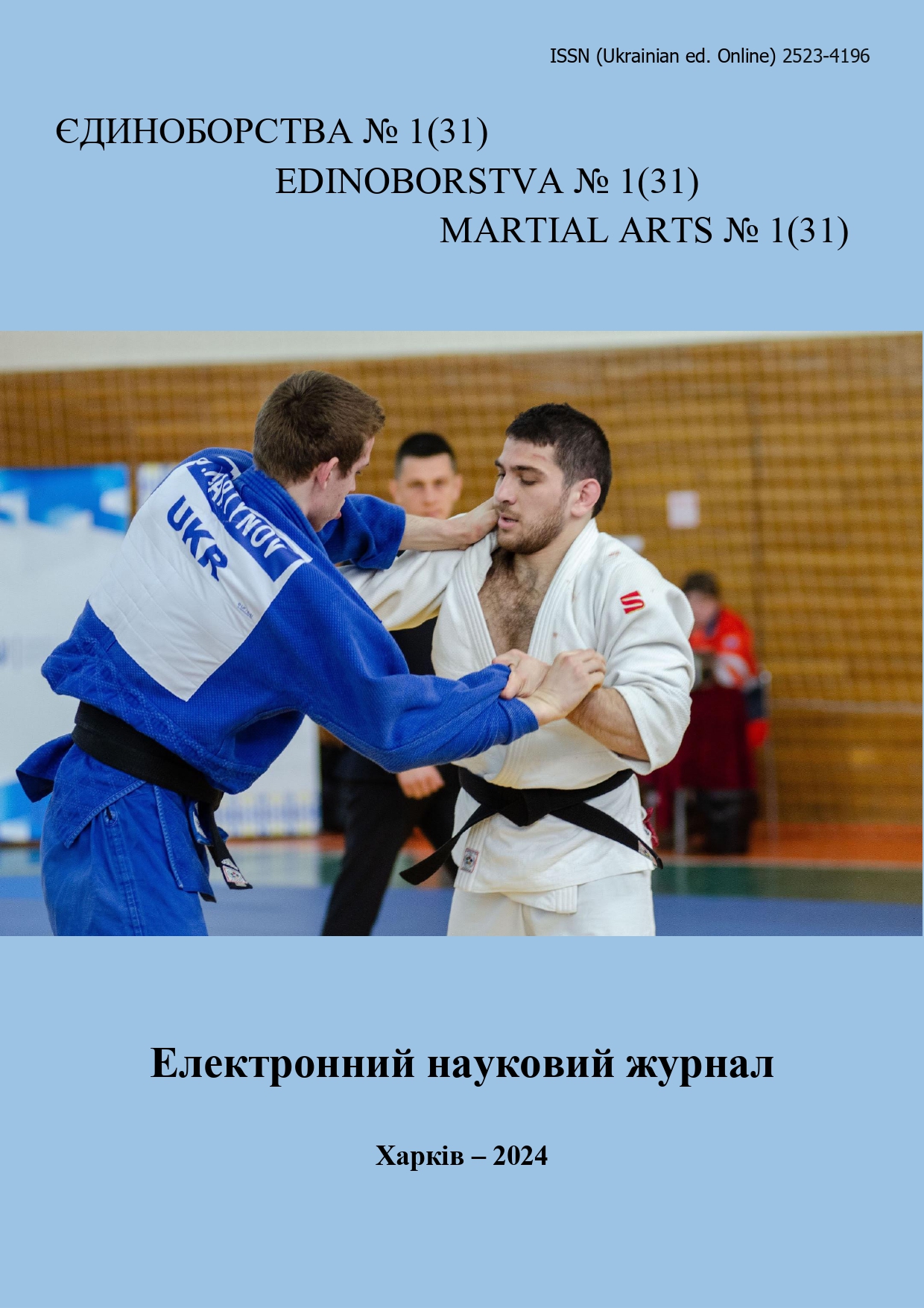Influence of health-improving aerobics classes with the use of martial arts exercises on physical fitness of female students
DOI:
https://doi.org/10.15391/ed.2024-1.09Keywords:
health-improving aerobics, martial arts, physical fitness, exercises, complex, imitation, motor abilitiesAbstract
Purpose: to study the influence of recreational aerobics classes using exercises from various types of martial arts on the level of physical fitness of female students. Material and methods. The following methods were used to achieve the aim of the study: analysis and synthesis of scientific and methodological literature, pedagogical experiment, method of control exercises (testing), pedagogical observation, methods of mathematical statistics. The study involved 1st and 2nd year female students (n=42) attending health aerobics classes. The students were divided into experimental (n=21) and control groups (n=21). Results: the comparison of physical qualities at the beginning of the experiment shows the lack of reliability of differences between them (p>0,05). In the course of the experiment the peculiarities of the methodology of conducting classes in health-improving aerobics were studied. The content of classes for female students was developed with the inclusion of exercises from different types of martial arts. The content included special imitation exercises (hook, jab, uppercut, etc.) and additional equipment from different types of martial arts (boxing, Thai boxing, kickboxing). Classes were held three times a week and lasted 60 minutes. At each lesson, a combination of 64 exercises was learned. The introduction of imitation exercises from different types of martial arts into the health aerobics classes had a positive effect on the results of the repeated testing of female students of the experimental group. At the end of the experiment in exercises of flexion and extension of arms in a lying down support, torso tilt forward from a sitting position and torso raising in a sit for 1 min. the results changed statistically significantly (p<0,001). This can be explained by the fact that martial arts exercises contribute to the development of strength abilities to the greatest extent, and exercises in health aerobics have a significant impact on the development of flexibility. The results in shuttle run 4×9 m, 100 m run and long jump from a place did not undergo significant changes (p>0,05), though there is a small tendency to positive changes. Conclusions. It is established that the use of imitation exercises from different types of martial arts in classes on health-improving aerobics, directed not only on the development of aerobic abilities, but also on mastering and improvement of techniques of movements from boxing, kickboxing and Thai boxing, positively influences the development of physical qualities of female students. It was found that as a result of attending classes, female students had a significant improvement in flexibility and strength of the arms and abdominal press (p<0,001). Indicators of coordination, speed, power and speed abilities also increased, but these changes are not significant (p>0,05).
References
Барсукова, Т.О., & Антіпова, Ж.І. (2021). Оздоровчий фітнес як засіб формування у студенток усвідомленої мотивації до фізичної активності. Науковий часопис Національного педагогічного університету імені М.П. Драгоманова. Науково-педагогічні проблеми фізичної культури (фізична культура і спорт), 8 (139), 23-28. DOI:10.31392/NPU-nc.series15.2021.8(139).04
Беляк, Ю., Грибовська, Ф., Музика, В., Іваночко, Л., & Чеховська, Л. (2018). Теоретико-методичні основи оздоровчого фітнесу : навч. посіб. ЛДУФК, Львів.
Благій, О., & Лисакова, Н. (2013). Тенденції розвитку групових фітнес-програм. Теорія і методика фізичного виховання і спорту, 2, 54-58.
Воловик, Н.І. (2015). Сучасні програми оздоровчого фітнесу : навч. посіб. НПУ імені М.П. Драгоманова, Київ
Гришко, Є.Ю., & Синиця, Т.О. (2021). Оздоровчий фітнес, як засіб проти надмірної маси тіла у жінок. Роль фізичної культури і спорту в збереженні та зміцненні генофонду нації, 48-51.
Драпинська, Я. (2021). Удосконалення фізичного виховання студенток технологічного коледжу засобами шейпінг-технологій. Спортивний вісник Придніпров’я. 1, 115-128.
Імас, Є., & Василенко, М. (2019). Діагностика сформованості праксеологічного компонента професійної компетентності майбутніх фітнес-тренерів у закладах вищої освіти. Вісник Кам'янець-Подільського національного університету. Фізичне виховання, спорт і здоров'я людини, 13, 34-39. DOI:10.32626/2227-62-46.2019-13.34-39
Кашуба, В. (2018). Із досвіду використання фітнес-технологій, спрямованих на корекцію тілобудови людини. Спортивний вісник Придніпров’я, 1, 131-138.
Колос, О., & Підлужняк, О. (2016). Визначення мотивації та ставлення студенток ВНТУ до занять оздоровчою аеробікою. Фізична культура, спорт та здоров’я нації, 20, 84-88.
Масляк, І. П. (2015). Комплексна оцінка впливу вправ степ-аеробіки на фізичну працездатність та фізичне здоров’я жінок. Теорія та методика фізичного виховання, 1, 37-43.
Пангелова, Н., Круцевич, Т., & Москаленко, Н. (2022). Сучасні підходи до класифікації фітнес-програм. Спортивний вісник Придніпров’я, 1, 78-87.
Петрович, В. (2013). Тай-бо як одна з нетрадиційних форм організації занять фізичними вправами серед студентів ІФКЗ. Молодіжний науковий вісник Східноєвропейського національного університету імені Лесі Українки, 9, 54-58.
Сергієнко, Л. П. (2010). Спортивна метрологія: теорія і практичні аспекти. Підручник. КНТ, Київ.
Середа, І. О. (2016). Педагогічні умови використання тай-бо аеробіки в процесі фізичного виховання студентів факультету іноземних мов Тернопільського національного педагогічного університету ім. В. Гнатюка. Науковий вісник Ужгородського університету. Педагогіка. Cоціальна робота, 1 (38), 245-247.
Сидорчук, Т., & Анастасьєва, З. (2018). Фізична підготовленість студенток під впливом занять за фітнес-програмою «Пілоксинг». Спортивний вісник Придніпров’я. 1, 233-235.
Синиця, С.В., Синиця, Т.О., Шестерова, Л.Є., & Корносенко, О.К. (2022). Модель майбутнього фітнес-тренера у процесі фахової підготовки у закладі вищої освіти. Спортивний вісник Придніпров’я, 2, 92-100. DOI:10.32540/2071-1476-2022-2-092
Синиця, Т., & Синиця, С. (2022). Сучасні підходи щодо використання аеробіки як засобу здоров’язбереження жінок. Технології здоров’язбереження: теорія і практика: колективна монографія. Полтава.
Хуртенко, О., Дмитренко, С., Хоронжевський, Л., & Кириченко, В. (2019). Використання інноваційних фітнес технологій у процесі відновлювальних занять кваліфікованих боксерів. Фізична культура, спорт та здоров’я нації, 8, 241-247.
Шестерова, Л.Є., & Пятницька, Д.В. (2020). Використання вправ з фітнес-гумками для попередження гіподинамії під час карантину у студентів ЗВО. Фізичне виховання та спорт в закладах вищої освіти, 53-56.
Шестерова, Л.Є., & Синиця, С.В. (2023) Роуп-скіппінг як засіб підвищення рухової активності людини. Сучасні погляди молоді на фізичну культуру, спорт та здоров’я людини, 225-227.
Kwak, L. Kremers, S.P.J., Bergman P., et. al. (2009). Associations between Physical Activity, Fitness, and Academic Achievement. The journal of pediatrics. 155, 6, 914-918. DOI:10.1016/j.jpeds.2009.06.019













